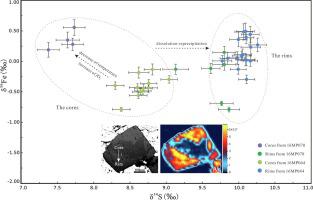Journal of Asian Earth Sciences ( IF 2.7 ) Pub Date : 2022-04-06 , DOI: 10.1016/j.jseaes.2022.105217 Yong-Wen Zhang 1, 2 , Hong-Rui Fan 1, 2, 3 , M. Santosh 4 , Lie-Wen Xie 2, 3 , Fang-Fang Hu 1, 2, 3 , Xuan Liu 5 , Huan-Long Hu 1, 2 , Xing-Hui Li 1, 3

|
Pyrite is an excellent archive for understanding geochemical behaviors of elements and isotopes in the course of ore formation. Here we present a combined textural-geochemical characterization of gold-related pyrites from the Muping deposit of Jiaodong gold province. Element mapping reveals core-rim texture, with the core being enriched in Pb, Ag, Cu, and Sn, whereas the rims in Au and As. Electron backscattered diffraction analysis shows consistent crystallographic orientation for both core and rim in pyrite. Simultaneous in-situ isotopic measurements unravel a coupled variation in Fe-S isotopes during pyrite growth and modification.
We interpret the core-rim texture as an indication of coupled dissolution-reprecipitation, where the cores precipitated from an initial fluid, and then dissolved and overgrown in response to cooling and oxidizing conditions. During this process, Pb, Ag, Cu, and Sn migrated out from the rims. Instead, Au were locked in the rims with the aid of As in the fluids. It is supposed that a variation of temperature and oxygen fugacity led to the disparity of Fe-S isotope of pyrite cores. Kinetic fractionation might account for the dispersion of Fe-S isotopic compositions of rims. The rims have relatively homogeneous S isotope composition. However, the variation of the Fe isotope of the rims was derived from different degrees of isotope exchange, suggesting that Fe isotope did not equilibrate with the mineralizing fluid. The different fractionation behavior of Fe-S isotopes in pyrite during fluid modification has a significant implication for reconstructing precipitation environment and tracing sources of ore-forming fluid and mineralization process.





















































 京公网安备 11010802027423号
京公网安备 11010802027423号